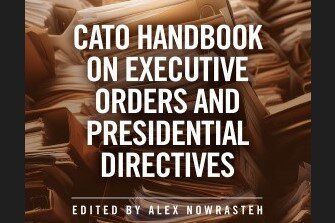Alex Nowrasteh
American presidents have enormous and growing power over our lives, liberty, and private property. Article II of the Constitution vests the president with “executive power,” which includes faithfully executing laws passed by Congress and acting as the commander in chief of the armed forces. For generations, successive Congresses have delegated much of their power to the president or stood idly by as presidents have usurped more power that is legislative in nature and effect. Much of this presidential power was redistributed and expanded in response to crises like wars, the Great Depression, and other emergencies, but the president’s power never fully receded after the conclusion of those crises.
My colleague Gene Healy wrote, “The modern presidency has become the central fault line of polarization in America because the president, increasingly, has the power to reshape vast swaths of American life.” As a result, we must focus more scrutiny on the president’s “formidable instruments of power”: executive orders (EOs) and other proclamations, memoranda, directives, executive agreements, edicts, and directives with the force of law.
The shifting of power from the Congress to the president and the resultant shrunken liberty of Americans prompted me to edit the first edition of the Cato Handbook on Executive Orders and Presidential Directives. The handbook has two goals. The first is to explain why the growth in executive and presidential power undermines individual liberty, limited government, free markets, peace, and the separation of powers as envisioned in our Constitution. The conclusion analyzes several reforms that would reverse the growth of executive power and properly confine the president’s power.
The second goal of the handbook is to provide a partial list and explanation of EOs and other directives that the next administration should revoke or amend. Many EOs and directives are legislative in nature or effect and reduce American liberty and prosperity, but a great number of them are innocuous or within the bounds of the president’s power. Without systemic reforms to presidential powers and the scope of EOs and directives that could be issued by the president, the next best alternative is to clear out the worst EOs. Thus, the handbook identifies EOs in policy issues as varied as the management of the administrative state, immigration, trade, foreign policy, national defense, health care, technology, energy, the environment, and more that the next president should revoke or amend.
The handbook is primarily intended to guide policymakers and the next incoming administration. In each chapter of the handbook, Cato scholars identify EOs and directives that create policy problems, explain those problems, whether the EO should be revoked or amended, and, if amendment is the answer, how the EOs should be amended. Presidents have more power than they used to and their authority will likely continue to grow. Even if the growth in presidential power continues, revoking or amending the EOs analyzed in the handbook along the lines suggested would at least improve policy.
We published the Cato Handbook for Policymakers in earlier years, which contains numerous policy recommendations for every issue researched by Cato scholars. The newly published Cato Handbook on Executive Orders and Presidential Directives does not replace that other handbook, it merely focuses recommendations on the president as his power becomes increasingly legislative.
As I wrote in the conclusion to the handbook:
The constitutional, legal, political, and judicial defects that have shifted some lawmaking power from Congress to the president must be discovered, remedied, and reversed lest the separation of powers be fatally undermined. James Madison warned of the tyrannical danger when legislative, executive, and judicial powers accumulate in the same hands, but that tendency toward centralized and unseparated power is most pronounced for the president, and EOs are his chief means of exercising undivided power .… Until such reforms and others become law, current or future administrations that are interested in stopping this constitutional hemorrhaging can start by revoking or amending the EOs identified in this handbook along the lines suggested by Cato scholars. The recommendations would improve public policy, reduce government power over the lives of Americans, and increase protection of individual liberties and private property. Those reasons justify their enactment, but much more needs to be done to reduce the impact of executive orders.
President Bill Clinton’s adviser, Paul Begala, blithely described the process and power of modern EOs as a “Stroke of the pen. Law of the land. Kind of cool.” If only he were wrong. Still, divisive and destructive EOs and directives created by the stroke of the pen can be undone by the stroke of the pen. The legal and constitutional drift that brought us to the point where presidents have this enormous power should worry all Americans. Too much power concentrated in a single individual is a tremendous threat to the constitutional order that has been indispensable in maintaining individual liberty, limited government, free markets, and peace that remain in the United States.
The prospect of reducing the power of the president to its proper constitutional role is slim, but following the recommendations in the Cato Handbook on Executive Orders and Presidential Directives would restore a significant amount of liberty to the American people. That alone is justification enough.

